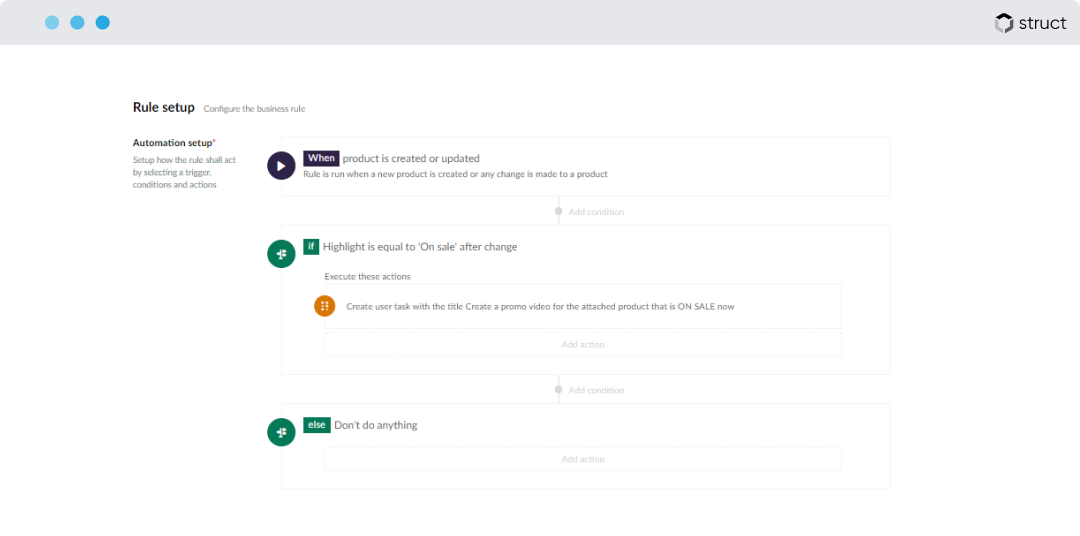Business rule engine is one of the most ground-breaking features to be introduced in a PIM system. The feature was introduced with the release of Struct PIM version 3.11.
It’s an extremely powerful feature that will open up doors to what’s possible with Struct PIM.
So, what is the Business rule engine?
We will explain the feature in more depth in this blog post, but for a simple explanation you can think along the lines of:
When this happens (aka trigger), then that needs to happen (aka action).
Take a few seconds to really understand the implications of the above statement.
Get it?
Yes, it actually allows you to set up business rules to automate processes within Struct PIM.
You can do things like:

But these are just quick examples we just thought of.
It’s entirely up to your imagination to create business rules that work wonders for your business.
The obvious place to start is by turning repetitive or time consuming manual processes into automations with business rules.
Along the way you might run into completely new and powerful ways to utilize Business rules in your business case.
Read along to find out how it works!
Accessing the Business rule engine in Struct PIM
When you’re logged into Struct PIM (and assuming your user has permissions to manage business rules), you simply navigate to Product model setup and then click on Business rules.
This opens up the Business rules overview page where you can view all the business rules created within your PIM.
Searching / filtering through Business rules in Struct PIM
As time passes your Struct PIM account could have many business rules listed here.
Which is where the search filters come in handy so you can quickly locate the particular rule you’re looking to work on.
You can filter the business rules based on their name, trigger name and/or active status (which can be either true or false).
This makes it easy to quickly find the exact rule you’re looking for, when there’s too many to keep track of.
See the short video below to see the search filter in action.
Understanding the components of a Business rule
Let’s take a closer look at triggers, conditions and actions, the three building block components of a Business rule. Here's the breakdown:

Triggers
A trigger is what initiates the rule. In the rule setup, the trigger component is displayed with a When label indicating its initiating purpose in the rule.
Conditions
After adding a trigger you can also add one or multiple conditions to further narrow down the business rule, so that it only gets triggered IF the conditions are met.
Adding a condition adds the if component to the rule.
Every additional condition adds an else if component to the rule.
The initial if condition gets evaluated and if it’s not met then the evaluation moves on to the else if condition and so on for each additional condition.
Actions
One or multiple actions can be executed once the triggering conditions are met.
If the rule doesn’t contain any conditions at all the execute these actions component gets added immediately after the when component.
Otherwise the execute these action components are nested under the if and else if conditional components as well as the default else component.
Available triggers, conditions and actions
You should note that the available conditions and actions depend on the trigger selected.
In the video below you can get a glimpse of the currently available triggers, conditions and actions.
However, please note that we might add new triggers, conditions and actions in the future.
Creating a new Business rule in Struct PIM
Creating a business rule is as simple as clicking the Create business rule button in the top right corner.
Then you’ll fill out the Basic settings by giving your business rule a name and optionally a description to further document its purpose.
Under Rule setup you can then start building out your rule using the no-code workflow builder, where you can build out the rule definition with an initiating trigger, one or multiple conditions and of course one or multiple actions.
If the rule is active you can then proceed to test out if everything works as intended.
Conclusion
As you can see business rules are one of the most powerful concepts to be introduced in a PIM system. It will open up doors to what’s possible with Struct PIM.
We gave you a few quick examples of ways you could use business rules.
However, the sky really is the limit and it’s entirely up to your imagination to create business rules that work wonders for your business.
The obvious place to start is by turning repetitive or time consuming manual processes into full blown automations with business rules.
Along the way you and your team might run into completely new and powerful ways to utilize Business rules in your business case.
If you have questions or comments about Business rules or any other feature in Struct PIM please reach out to us today.

